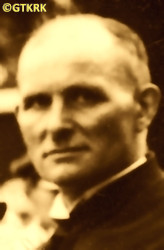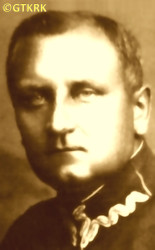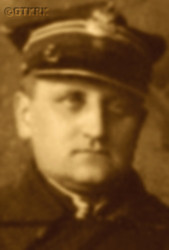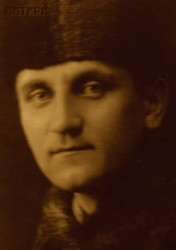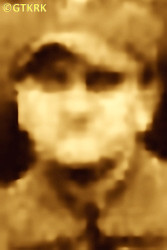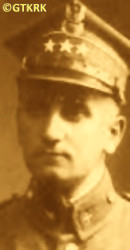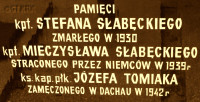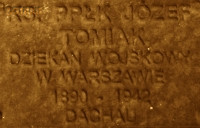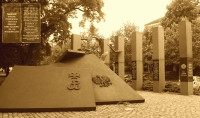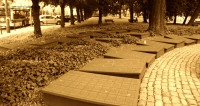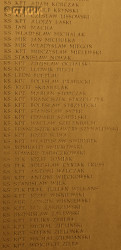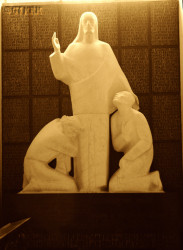Roman Catholic
St Sigismund parish
05-507 Słomczyn
85 Wiślana Str.
Konstancin deanery
Warsaw archdiocese, Poland
full list:
displayClick to display full list

searchClick to search full list by categories
wyświetlKliknij by wyświetlić pełną listę po polsku

szukajKliknij by przeszukać listę wg kategorii po polsku

Martyrology of the clergy — Poland
XX century (1914 – 1989)
personal data
surname
TOMIAK
forename(s)
Joseph (pl. Józef)
function
diocesan priest
creed
Latin (Roman Catholic) Church RCmore on
en.wikipedia.org
[access: 2014.09.21]
diocese / province
Gniezno and Poznań archdiocese (aeque principaliter)more on
www.archpoznan.pl
[access: 2012.11.23]
RC Military Ordinariate of Polandmore on
en.wikipedia.org
[access: 2014.12.20]
honorary titles
Gold „Cross of Merit”more on
Gold „Cross of Merit”
(10.11.1938)
„Cross of Valour”more on
„Cross of Valour”
date and place
of death
08.08.1942

KL Dachauconcentration camp
today: Dachau, Upper Bavaria reg., Bavaria state, Germany
more on
en.wikipedia.org
[access: 2016.05.30]
alt. dates and places
of death
09.08.1942
details of death
During his studies at the Germ. Königliches Gymnasium (Eng. Royal Gymnasium) in Międzyrzecz, a member of the clandestine Thomas Zan Society.
In 1915 drafted into the German Imperial. Prob. from the beginning served in the Germ. 89. Infanterie–Division (Eng. 89th Infatry Division), which bore this name from 08.1915, but was formed in Poznań on 11.1914 as the Germ. Division Westernhagen, after its commander. In 1915 the Division fought on the Eastern Front, taking part in the battles to push the Russians eastwards — after the triumph of the Central Powers (Germany and Austria–Hungary) in the Battle of Gorlice on 02‐05.05.1918. It took part in the battles of Warsaw in 08.1915, on the Neman river on 19.08‐08.09.1915, near Vilnius on 09.09‐02.10.1915. Then from 26.11.1915, it began to defend the Berezina River line in northeastern Belarus. At some point during this campaign, became its chaplain and medical orderly.
On 27.08.1916, Romania declared war on the Central Powers and attacked Transylvania, which was part of the Austro–Hungarian Empire. His Division was then transferred to the Romanian front. On 11.09.1916‐08.01.1917 it took part in the struggles during which the Romanian army was pushed back towards Moldavia — starting with the battle of Nagyszeben, through Fogaraș, the clashes in the Perșani Mountains, near Brașov on 07‐09.10.1916, for the mountain passes near Predeal, on the Ialomița and Buzău rivers, on the Râmnicu Sărat river, to the battle of the Putna river and the establishment of the front on the Putna and Seret rivers. There it took part in the largest battle on the Romanian front, at Mărășești.
06‐10.08.1917, during which the Central Powers forces failed to break through the front line defended by the Romanians and the Russians supporting them. In the battle, in which c. 500,000 soldiers took part altogether, the losses of both sides amounted to c. 120,000 killed and wounded.
On 10.12.1917, an armistice was signed in Focşani. Two days before, however, was captured by the Romanians. Released prob. in the spring of 1918. This prob. took place after the signing of the Brest Peace Treaty on 03.03.1918 between the Central Powers and Bolshevik Russia — the Bolsheviks took power in Russia in 11.1918 in a coup sponsored by the Germans. For Romania this meant de facto encirclement by the Central Powers and forced it to sign the Bucharest Treaty of 07.05.1918, which ended Romania's participation in the war. Perhaps then, perhaps a little earlier, or perhaps later on c. 02.11.1918, when his Division withdrew from Romania, returned to his diocese.
After the abdication on 09.11.1918 of the German Emperor William II Hohenzollern; after the signing on 11.11.1918 by the Allies and the Germans, in the staff wagon in Compiègne, at the headquarters of French Marshal Ferdinand Foch, of the armistice and ceasefire — which de facto meant the end of World War I; and also after the handover on 11.11.1918 by the Regency Council – operating in the so‐called Germ. Königreich Polen (Eng. Polish Kingdom) occupied by the Central Powers (Germany and Austria–Hungary) — of supreme command over the army to Brigadier Joseph Piłsudski and his appointment as Commander‐in‐Chief of the Polish Army, which de facto meant the rebirth of the Polish state, encompassing however only the Germ. Königreich Polen, i.e. the Polish territory under Russian rule until 1915, but excluding the lands of the Prussian partition; Greater Poland — as the Prussian Germ. Provinz Posen (Eng. Poznań Province) — was still formally part of the German state. Took then part in the Greater Poland Uprising of 1918‐1919 that started on 27.12.1918 in Poznań. The Uprising ended on 16.02.1919 with the armistice in Trier, enforced by the victorious Entente states, under which the Polish insurgent Greater Poland Army was recognised as an allied army and a border was set, which „German troops were forbidden to cross”, leaving a large part of Greater Poland outside their influence. However, it was not until the Treaty of Versailles, concluded on 28.06.1919, that Greater Poland was awarded to Poland. It formally joined it on 10.01.1920, after the ratification of the treaty by all parties.
Even before the signing of the Treaty of Versailles, formally became — on c. 01.05.1919 — chaplain of the Greater Poland Army. Was assigned to the 3rd Greater Poland Field Artillery Regiment, established by an order of 16.05.1919 and formed from several smaller insurgent divisions, including one of the divisions of the 1st Light Artillery Regiment. The Regiment left for the Lithuanian–Belarusian Front of the Polish–Russian War of 1919‐1921 in 08.1919. On 03‐04.08.1919 reached Radaškovičy station, c. 35 km north of Minsk. On 08.08.1919 took part in the attack and capture of Minsk. After a forced march to the south, started on 10.08.1919, took part in the battle for Bobruysk 28.08‐03.09.1919, capturing the city. The Polish offensive of 06‐12.1919 led to the Polish–Russian L‐B front stoping at the line of Berezina and Dvina rivers in the north. The Regiment defended the Berezina River in the vicinity of Bobruysk, although some units took part in the battles n. Polotsk on the Dvina. And it was then that the 1st Greater Poland Rifle Regiment, which had been taking part until then in the Polish–Ukrainian war 1918‐1919, reached the Berezina. At some point became the chaplain of this Regiment. It may have happened in 01.1920, after the Treaty of Versailles came into force, when both regiments formally became units of the Polish Army and changed their names: 1st Greater Poland Artillery Regiment to 14th Greater Poland Light Artillery Regiment, and 1st Greater Poland Rifle Regiment to 55th Poznań Infantry Regiment. In the spring, perhaps the first major attempt at a Russian offensive took place. Both regiments took part in the Battle of Shatylky on 09‐22.04.1920, where a strategic bridge over the Berezina River was located. In a later application for the Cross of Valor, his attitude was described as follows: on a sortie organized by the regiment on 17‐18.04.1920 from Shatylky to the village of Borovyky, c. 10 km away, „went on his own initiative [...] and in the heaviest fighting that ensued when capturing the battery at Borovyky, was in the front line, confessing the wounded and blessing those going into battle. Having endured the greatest intensity of fire, his conduct and encouraging words had a calming effect on those around him, which, given the general tension in nerves, was an extremely positive sign”. The Poles held their positions. After the start of the great Russian offensive in the north on 04.07.1920 under the command of General Mikhail Tukhachevsky, his Regiment — by then it was the 55th Regiment — from 09.07.1920 began to withdraw to the west. In constant clashes with the advancing Russians, among others, by Bereza Kartuska, during an attempt to defend the Bug line, until on 14.08.1920 reached the Vistula line, the village of Gołąb near Dęblin.
From there, on 16.08.1920, the Polish counter–offensive from the Wieprz River began, part of the victorious, decisive Battle of Warsaw (known as the „Miracle on the Vistula”). All Polish units retreating from the Berezina River struck north from Dęblin, cutting the Russian northern front in half. His Regiment marched to Kołbiel and 14 km further on to Mińsk Mazowiecki. This is how his attitude was described: „On 17.08.1920 […] stayed on the outskirts of Kołbiel with the wounded […] Meanwhile, a Bolshevik brigade was approaching from the west, trying to exploit the gap […] Although was perfectly aware […] of the danger threatening him […], maintained an iron calm together with balance and did not abandon the wounded, trying to come to their aid as much as possible. Although the enemy was just 300 meters from the city, and the dressing point where was located […] was under heavy fire, calmly held his position until the 7th company managed to arrive and put an end to the enemy's advance” (Ibid.). The pursuit of the Russians began. Some were pushed to German Prussia, where they were interned; most fled to the east. The Regiment chased the Russians, taking part, among others, in battles in the vicinity of Brest on the Bug, including at Zhabynka, and then Kobryn, which were part of the great Battle of the Neman river on 20‐26.09.1920. In continuous fighting along the road to Minsk, on 11.10.1920 it reached Koydaniv, c. 35 km from Minsk. There „often hurried to the front lines amidst the murderous fire with which the enemy was constantly shelling our backs, to bring aid to the wounded there […] Did not stop his devout work for a moment until the bloody fighting had completely died down. With his calmness and self‐denial had a very positive influence on the behaviour of the soldiers” (Ibid.). On 14.10.1920 the Regiment entered Minsk again, to end the war operations the next day, on 15.10.1920, in connection with the armistice signed in Riga.
On 24.12.1920, the Regiment returned to Greater Poland, to Krotoszyn.
Later, as a chaplain of the 3rd Greater Poland Field Artillery Regiment (or 55th Infantry Regiment), participated in the final battles with the Ukrainians, during the Polish–Ukrainian War 1918‐1920, and with the Russians, during the Polish–Russian War of 1919–1921.
In peacetime, from 1921, chaplain in active service in the Polish Army.
Prob. in 08.1939, appointed dean of the Roman Catholic Pastoral Service at the Command of Corps District DOK No. VII Poznań and at the same time head of the Roman Catholic Pastoral Service at the „Poznań” Army.
His fate during the first months of World War II was connected with this last function and the „Poznań”Army staff. The „Poznań”Army began mobilization in 08.1939, and its commander, General Thaddeus Kutrzeba, arrived in the mobilization area — Gniezno — with his staff on 29.08.1939. The war broke out after the German attack on Poland on 01.09.1939 (the Russians attacked Poland 17 days later). Due to the fact that the German attack basically bypassed Greater Poland — the main German forces attacked from the north and south further east, bypassing the „Poznań” Army, the westernmost part of the Polish armed forces — the „Poznań”Army began from 5.09.1939 to retreat east, towards Warsaw, without fighting. On 09.09.1939 however, on the initiative of General Kutrzeba and with the consent of the high command, undertook military operations, which turned into the largest battle of the 09.1939 campaign, known as the Battle of Bzura. As a result of the lost battle — c. 15,000 Polish soldiers died, including 3 generals (German losses were about half as huge) — General Kutrzeba on 21.09.1939 disbanded the „Poznań” Army. The next day, he and his staff managed to get to the already surrounded Warsaw.
In the last days of the siege of Warsaw ministerd in one of the Warsaw field hospitals.
On 29.09.1939, after the capitulation of the capital, captured by the Germans in Warsaw.
Initially prob. treated equally with the officer staff, including members of the staff of the former „Poznań” Army. Transported to the Oflag VII A Murnau officer POW camp (prob. through the Oflag X B Nienburg and Oflag XVIII C Spittal an der Drau officer POW camps).
From there, in 12.1939, transported to Oflag IX C Rotenburg an der Fulda POW camp — there served as dean of a group of chaplains detained in the camp and, among others, conducted talks with the German camp command.
From there on 18.04.1940, in contravention of Geneva conventions of 27.07.1929, transported to KL Buchenwald concentration camp where slaved in quarries.
Finally on 06‐07.07.1942 moved to KL Dachau concentration camp where perished: contracted cellulitis and dysentery and in camp's „hospital” received lethal injection.
According to the death certificate, prepared in KL Dachau, the „honest” otherwise German „medical doctors” and formalists — and at the same time, unrivaled fairy tale spinners — noted that the cause of death Germ. „Versagen von Herz und Kreislauf, bei Phlegmone am rechten Unterschenkel” (Eng. „Heart and circulatory failure, due to phlegmon on the right lower leg”).
alt. details of death
According to some sources, was captured by Romania on 08.12.1918 and released in the spring of 1919. This seems unlikely for three reasons. First, it would have been after his Division had returned to Germany. Second, it would have been after the end of World War I on 11.11.1918. Third, could not have then taken part in the Greater Poland Uprising, what some sources indicate.
prisoner camp's numbers
31235Click to display source page (KL DachauClick to display the description), 2185Click to display source page (KL BuchenwaldClick to display the description)
cause of death
murder
perpetrators
Germans
sites and events
KL DachauClick to display the description, KL BuchenwaldClick to display the description, Oflag IX C Rotenburg an der FuldaClick to display the description, Oflag VII A MurnauClick to display the description, Oflag XVIII C Spittal an der DrauClick to display the description, Oflag X B NienburgClick to display the description, Ribbentrop‐MolotovClick to display the description, Pius XI's encyclicalsClick to display the description, Polish‐Russian war of 1919‐1921Click to display the description, Thomas Zan SocietiesClick to display the description
date and place
of birth
19.03.1890Birth certification on:
photos.szukajwarchiwach.gov.pl
[access: 2025.04.13]

Wolsztyntoday: Wolsztyn gm., Wolsztyn pov., Greater Poland voiv., Poland
more on
en.wikipedia.org
[access: 2021.07.18]
parents
TOMIAK Valentine
🞲 ?, ? — 🕆 ?, ?

MASZNER Veronica
🞲 ?, ? — 🕆 ?, ?
presbyter (holy orders)
ordination
19.12.1914

Gnieznotoday: Gniezno urban gm., Gniezno pov., Greater Poland voiv., Poland
more on
en.wikipedia.org
[access: 2021.12.18]
Assumption of the Blessed Virgin Mary RC archcathedral churchmore on
en.wikipedia.org
[access: 2025.03.14]
positions held
1939
RC military pastor — Command of the Corps District DOK No. VII Poznań, Polish Armed Forces — acting („ad interim”) dean; appointed prob. in 08.1939
02.05.1936 – 1939
RC military pastor — Warsawtoday: Warsaw city pov., Masovia voiv., Poland
more on
en.wikipedia.org
[access: 2021.10.09] ⋄ Command of the Corps District DOK No. I Warsaw, Polish Armed Forces ⋄ RC military parish — head of the District's pastoral care; promoted to pastor of the Roman Catholic military clergy with seniority from 01.01.1936, in the rank of lieutenant colonel
01.09.1929 – 1936
RC senior military chaplain — Poznańtoday: Poznań city pov., Greater Poland voiv., Poland
more on
en.wikipedia.org
[access: 2021.07.18] ⋄ Corps District OK No. VII Poznań, Polish Armed Forces ⋄ St Joseph Spouse of the Blessed Virgin Mary RC military parish — deputy dean of the District; also: administrator of the military parish
31.03.1925 – 1929
RC senior military chaplain — Poznańtoday: Poznań city pov., Greater Poland voiv., Poland
more on
en.wikipedia.org
[access: 2021.07.18] ⋄ military RC Pastoral District, Corps District OK No. VII Poznań, Polish Armed Forces ⋄ St Joseph Spouse of the Blessed Virgin Mary RC military parish — head of the pastoral district; also: c. 1929 chaplain of „Poznań” garrison
c. 1921 – 1925
RC senior military chaplain — Gnieznotoday: Gniezno urban gm., Gniezno pov., Greater Poland voiv., Poland
more on
en.wikipedia.org
[access: 2021.12.18] ⋄ military RC Pastoral District, Corps District OK No. VII Poznań, Polish Armed Forces ⋄ St Stanislav the Bishop and Martyr RC military parish — head of the pastoral district; by decree of the Chief of State of ‐03.05.1922, confirmed with seniority from 01.06.1919 and 25th place on the list of Roman Catholic senior military chaplains, in the rank of major; by L. 3448 decree of the Commander‐in‐Chief of 16.12.1921, verified with seniority with seniority from 01.04.1920 and 28th place on the list of Roman Catholic military senior chaplains, in the rank of major; resident by the Holy Trinity church; also: in 1921 ran courses for illiterate people, lecturer of Polish history and literature
1920 – c. 1921
RC military chaplain — 55th Poznań Infantry Regiment, 14th Greater Poland Infantry Division, Polish Armed Forces — formally accepted into the Polish Army as a chaplain by L. 2238 decree of the Commander‐in‐Chief of 30.07.1920
1919 – 1920
RC military chaplain — 3rd Greater Poland Field Artillery Regiment, Greater Poland Army (i.e. Polish Armed Forces in the former Prussian Partition), Polish Armed Forces
1915 – 1918
RC military chaplain — niem. 89. Infanterie–Division (89th Infantry Division), German Imperial Army
1915
vicar — Winna Góratoday: Środa Wielkopolska gm., Środa Wielkopolska pov., Greater Poland voiv., Poland
more on
en.wikipedia.org
[access: 2022.02.03] ⋄ St Michael the Archangel RC parish ⋄ Miłosławtoday: Miłosław gm., Września pov., Greater Poland voiv., Poland
more on
en.wikipedia.org
[access: 2021.07.18] RC deanery
1915
vicar — Słupiatoday: Stęszew gm., Poznań pov., Greater Poland voiv., Poland
more on
en.wikipedia.org
[access: 2021.07.18] ⋄ All the Saints RC parish ⋄ Stęszewtoday: Stęszew gm., Stęszew pov., Greater Poland voiv., Poland
more on
en.wikipedia.org
[access: 2021.06.20] RC deanery
till 1915
student — Gnieznotoday: Gniezno urban gm., Gniezno pov., Greater Poland voiv., Poland
more on
en.wikipedia.org
[access: 2021.12.18] ⋄ philosophy and theology, Archbishop's Practical Theological Seminary (Lat. Seminarium Clericorum Practicum)
from 1910
student — Poznańtoday: Poznań city pov., Greater Poland voiv., Poland
more on
en.wikipedia.org
[access: 2021.07.18] ⋄ philosophy and theology, Archbishop's Theological Seminary (Collegium Leoninum)
others related
in death
BELONClick to display biography Zdislav Anthony, BRYDACKIClick to display biography Louis Cyprian, DACHTERAClick to display biography Francis, DRWALClick to display biography Francis, FRANCUZClick to display biography John, GÓRALIKClick to display biography John, JĘDRYSIKClick to display biography Severin (Fr Vincent Mary), KLARZAKClick to display biography Joseph, KRYŃSKIClick to display biography Adolph Bernard, LISSOWSKIClick to display biography Ceslav Joseph, MICHUŁKAClick to display biography John, MIEGOŃClick to display biography Vladislav, STOPCZAKClick to display biography Marian Conrad, SYPERClick to display biography Stanislav, SZABELSKIClick to display biography Edward Bronislav, ŚWIDEREKClick to display biography Vladislav, TRUSSClick to display biography Cyriac Boleslav, ZAKRZEWSKIClick to display biography John, ZIEMIAŃSKIClick to display biography Michael Urban, ZIĘBAClick to display biography Adalbert
sites and events
descriptions
KL Dachau: KL Dachau in German Bavaria, set up in 1933, became the main German Germ. Konzentrationslager (Eng. concentration camp) KL for Catholic priests and religious during World War II: On c. 09.11.1940, Reichsführer‐SS Heinrich Himmler, head of the SS, Gestapo and German police, as a result of the Vatican's intervention, decided to transfer all clergymen detained in various concentration camps to KL Dachau camp. The first major transports took place on 08.12.1940. In KL Dachau Germans held approx. 3,000 priests, including 1,800 Poles. The priests were forced to slave labor in the Germ. „Die Plantage” — the largest herb garden in Europe, managed by the genocidal SS, consisting of many greenhouses, laboratory buildings and arable land, where experiments with new natural medicines were conducted — for many hours, without breaks, without protective clothing, no food. They slaved in construction, e.g. of camp's crematorium. In the barracks ruled hunger, freezing cold in the winter and suffocating heat during the summer, especially acute in 1941‐1942. Prisoners suffered from bouts of illnesses, including tuberculosis. Many were victims of murderous „medical experiments” — in 11.1942 c. 20 were given phlegmon injections; in 07.1942 to 05.1944 c. 120 were used by for malaria experiments. More than 750 Polish clerics where murdered by the Germans, some brought to TA Hartheim euthanasia centre set up in Schloss Hartheim in Austria and murdered in gas chambers. At its peak KL Dachau concentration camps’ system had nearly 100 slave labour sub‐camps located throughout southern Germany and Austria. There were c. 32,000 documented deaths at the camp, and thousands perished without a trace. C. 10,000 of the 30,000 inmates were found sick at the time of liberation, on 29.04.1945, by the USA troops… (more on: www.kz-gedenkstaette-dachau.deClick to attempt to display webpage
[access: 2013.08.10], en.wikipedia.orgClick to attempt to display webpage
[access: 2016.05.30])
KL Buchenwald: In German Germ. Konzentrationslager (Eng. concentration camp) KL Buchenwald concentration camp, founded in 1937 and operational till 1945, Germans held c. 238,380 prisoners and murdered approx. 56,000 of them, among them thousands of Poles. Prisoners were victims of pseudo‐scientific experiments, conducted among others by Behring‐Werke from Marburg and Robert Koch Institute from Berlin companies. They slaved for Gustloff in Weimar and Fritz‐Sauckel companies manufacturing armaments. To support Erla‐Maschinenwerk GmbH in Leipzig, Junkers in Schönebeck (airplanes) and Rautal in Wernigerode Germans organized special sub‐camps. In 1945 there were more than 100 such sub‐camps. Dora concentration camp was initially one of them, as well as KL Ravensbrück sub‐camps (from 08.1944). On 08.04.1945 Polish prisoner, Mr Guido Damazyn, used clandestinely constructed short wave transmitter to sent, together with a Russian prisoner, a short message begging for help. It was received and he got a reply: „KZ Bu. Hold out. Rushing to your aid. Staff of Third Army” (American). Three days later the camp was liberated. (more on: www.buchenwald.deClick to attempt to display webpage
[access: 2013.08.10], en.wikipedia.orgClick to attempt to display webpage
[access: 2013.08.10])
Oflag IX C Rotenburg an der Fulda: German POW prisoner of war camp for officers in Rotenburg an der Fulda in Hesse. C. 60‐70 Polish Catholic priests, most of them military chaplains, captured by the Germans in 09.1939 during German invasion of Poland, were held POW there from 12.1939. In preparations for invasion of France all on 18.04.1940 were sent — in contravention of Geneva conventions of 27.07.1929 — to KL Buchenwald concentration camps. From 06.1940 Germ. Zweiglager (Eng. sub‐camp) of Oflag IX A/H Spangenberg and renamed Oflag IX A/Z. (more on: en.wikipedia.orgClick to attempt to display webpage
[access: 2019.11.17])
Oflag VII A Murnau: German POW camp for Polish officers in Murnau am Staffelsee in Bavaria, set up in 09.1939 (first POW were brought in on 06.10.1939). Up to of 5,457 (including 5,114 Poles and among them at least 31 generals) were held POW there. The camp was established in barracks — built in 1939 for c. 600 soldiers — which were practically unfinished until the end of the camp's operation. As the numbers in the camp increased, attics and basements in residential buildings and garages were converted into rooms. The camp was liberated on 29.04.1945 by a unit of American troops. (more on: en.wikipedia.orgClick to attempt to display webpage
[access: 2019.11.17])
Oflag XVIII C Spittal an der Drau: From 11.11.1939 to 05.1940, after the outbreak of World War II, in former military barracks near Spittal an der Drau, on the Drau river, in Austrian Carinthia, the Germans held c. 891 Polish officers, mainly those taking part in the defense of Warsaw and the Coast, interned in 09.1939, transferred from Oflag X B Nienburg. On 30‐31.05.1940 the prisoners were transferred to Oflag II C Woldenberg. From 02.07.1940 it held French officers interned during the invasion of France, 1,272 in total. In 01.1941 the French prisoners were transferred to other camps. (more on: www.cmjw.plClick to attempt to display webpage
[access: 2024.12.13])
Oflag X B Nienburg: From 09.1939 to 05.1940, after the outbreak of World War II, in military barracks Germ. Mudra‐Kaserne (Eng. Mudra barracks) near the town of Nienburg (Weser) in Lower Saxony, the Germans held about 1,000 Polish officers, mainly from „Poznań” and „Pomorze” Armies of the Polish Armed Forces, interned in 09.1939. In 03.1940, the transports of officers to another POW camp, Oflag X A Itzehoe, began. At that time, the construction of a new POW camp began nearby. From 05.1940 French officers interned during the invasion of France were held there. The camp was liberated on 09.04.1945 by the British. (more on: pl.wikipedia.orgClick to attempt to display webpage
[access: 2013.08.17])
Ribbentrop‐Molotov: Genocidal Russian‐German alliance pact between Russian leader Joseph Stalin and German leader Adolf Hitler signed on 23.08.1939 in Moscow by respective foreign ministers, Mr. Vyacheslav Molotov for Russia and Joachim von Ribbentrop for Germany. The pact sanctioned and was the direct cause of joint Russian and German invasion of Poland and the outbreak of the World War II in 09.1939. In a political sense, the pact was an attempt to restore the status quo ante before 1914, with one exception, namely the „commercial” exchange of the so‐called „Kingdom of Poland”, which in 1914 was part of the Russian Empire, fore Eastern Galicia (today's western Ukraine), in 1914 belonging to the Austro‐Hungarian Empire. Galicia, including Lviv, was to be taken over by the Russians, the „Kingdom of Poland” — under the name of the General Governorate — Germany. The resultant „war was one of the greatest calamities and dramas of humanity in history, for two atheistic and anti‐Christian ideologies — national and international socialism — rejected God and His fifth Decalogue commandment: Thou shall not kill!” (Abp Stanislav Gądecki, 01.09.2019). The decisions taken — backed up by the betrayal of the formal allies of Poland, France and Germany, which on 12.09.1939, at a joint conference in Abbeville, decided not to provide aid to attacked Poland and not to take military action against Germany (a clear breach of treaty obligations with Poland) — were on 28.09.1939 slightly altered and made more precise when a treaty on „German‐Russian boundaries and friendship” was agreed by the same murderous signatories. One of its findings was establishment of spheres of influence in Central and Eastern Europe and in consequence IV partition of Poland. In one of its secret annexes agreed, that: „the Signatories will not tolerate on its respective territories any Polish propaganda that affects the territory of the other Side. On their respective territories they will suppress all such propaganda and inform each other of the measures taken to accomplish it”. The agreements resulted in a series of meeting between two genocidal organization representing both sides — German Gestapo and Russian NKVD when coordination of efforts to exterminate Polish intelligentsia and Polish leading classes (in Germany called «Intelligenzaktion», in Russia took the form of Katyń massacres) where discussed. Resulted in deaths of hundreds of thousands of Polish intelligentsia, including thousands of priests presented here, and tens of millions of ordinary people,. The results of this Russian‐German pact lasted till 1989 and are still in evidence even today. (more on: en.wikipedia.orgClick to attempt to display webpage
[access: 2015.09.30])
Pius XI's encyclicals: Facing the creation of two totalitarian systems in Europe, which seemed to compete with each other, though there were more similarities than contradictions between them, Pope Pius XI issued in 03.1937 (within 5 days) two encyclicals. In the „Mit brennender Sorge” (Eng. „With Burning Concern”) published on 14.03.1938, condemned the national socialism prevailing in Germany. The Pope wrote: „Whoever, following the old Germanic‐pre‐Christian beliefs, puts various impersonal fate in the place of a personal God, denies the wisdom of God and Providence […], whoever exalts earthly values: race or nation, or state, or state system, representatives of state power or other fundamental values of human society, […] and makes them the highest standard of all values, including religious ones, and idolizes them, this one […] is far from true faith in God and from a worldview corresponding to such faith”. On 19.03.1937, published „Divini Redemptoris” (Eng. „Divine Redeemer”), in which criticized Russian communism, dialectical materialism and the class struggle theory. The Pope wrote: „Communism deprives man of freedom, and therefore the spiritual basis of all life norms. It deprives the human person of all his dignity and any moral support with which he could resist the onslaught of blind passions […] This is the new gospel that Bolshevik and godless communism preaches as a message of salvation and redemption of humanity”… Pius XI demanded that the established human law be subjected to the natural law of God , recommended the implementation of the ideal of a Christian state and society, and called on Catholics to resist. Two years later, National Socialist Germany and Communist Russia came together and started World War II. (more on: www.vatican.vaClick to attempt to display webpage
[access: 2023.05.28], www.vatican.vaClick to attempt to display webpage
[access: 2023.05.28])
Polish‐Russian war of 1919‐1921: War for independence of Poland and its borders. Poland regained independence in 1918 but had to fight for its borders with former imperial powers, in particular Russia. Russia planned to incite Bolshevik‐like revolutions in the Western Europe and thus invaded Poland. Russian invaders were defeated in 08.1920 in a battle called Warsaw battle („Vistula river miracle”, one of the 10 most important battles in history, according to some historians). Thanks to this victory Poland recaptured part of the lands lost during partitions of Poland in XVIII century, and Europe was saved from the genocidal Communism. (more on: en.wikipedia.orgClick to attempt to display webpage
[access: 2014.12.20])
Thomas Zan Societies: Secret societies of Polish youth, aiming at self‐education, patriotic in form and content, functioning 1830‐1920, in mutiny against enforced Germanisation and censure of Polish culture, mainly in secondary schools — gymnasia — mainly in Greater Poland (Wielkopolska) and later in Silesia. The first groups were formed in 1817. In 1897 a congress in Bydgoszcz was held when rules of clandestine activities were formulated. At other congress in Bydgoszcz in Poznań a „Red Rose” society was formed, heading all others groups in various gymnasiums and coordinating their activities. In 1900 „Red Rose” consolidated Philomaths organizations from Pomerania as well. After Toruń trial of Pomeranian Philomaths in Toruń Germans arrested 24 members of Thomas Zan Society from Gniezno. 21 of them were sentenced up to 6 weeks in prison and reprimands. All were relegated from schools without the right to continue education in secondary and higher schools in Prussia. Despite repression the Societies existed till 1918 and rebirth of Poland. (more on: pl.wikipedia.orgClick to attempt to display webpage
[access: 2021.12.19])
sources
personal:
www.bohaterowie1939.plClick to attempt to display webpage
[access: 2016.08.14], photos.szukajwarchiwach.gov.plClick to attempt to display webpage
[access: 2025.04.13], www.ipgs.usClick to attempt to display webpage
[access: 2012.11.23], ordynariat.wp.mil.plClick to attempt to display webpage
[access: 2024.12.13]
bibliographical:
„Social Activist Priests in Greater Poland”, collective work, Biographical Dictionary, vol. 4 Ś‐Ż, Gniezno 2009
„International Tracing Service (ITS), Bad Arolsen, GermanyClick to display source page”, Arolsen Archives
original images:
audiovis.nac.gov.plClick to attempt to display webpage
[access: 2016.08.14], ordynariat.wp.mil.plClick to attempt to display webpage
[access: 2024.12.13], www.facebook.comClick to attempt to display webpage
[access: 2016.08.14], www.wtg-gniazdo.orgClick to attempt to display webpage
[access: 2012.12.28], doi.orgClick to attempt to display webpage
[access: 2021.10.09], www.wtg-gniazdo.orgClick to attempt to display webpage
[access: 2012.12.28], hinterstacheldraht.jimdo.comClick to attempt to display webpage
[access: 2016.03.14], www.powiatwolsztyn.plClick to attempt to display webpage
[access: 2014.01.06], www.katedrapolowa.plClick to attempt to display webpage
[access: 2014.01.16]
LETTER to CUSTODIAN/ADMINISTRATOR
If you have an Email client on your communicator/computer — such as Mozilla Thunderbird, Windows Mail or Microsoft Outlook, described at WikipediaPatrz:
en.wikipedia.org, among others — try the link below, please:
LETTER to CUSTODIAN/ADMINISTRATORClick and try to call your own Email client
If however you do not run such a client or the above link is not active please send an email to the Custodian/Administrator using your account — in your customary email/correspondence engine — at the following address:

giving the following as the subject:
MARTYROLOGY: TOMIAK Joseph
To return to the biography press below:
 Click to return to biography
Click to return to biography








